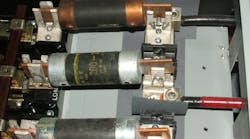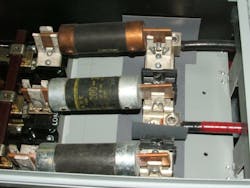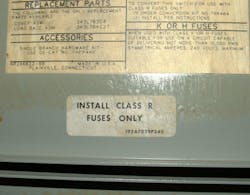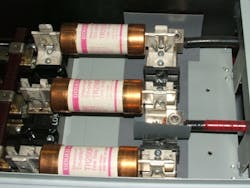How well do you know the Code? Think you can spot violations the original installer either ignored or couldn't identify? Here's your chance to moonlight as an electrical inspector and second-guess someone else's work from the safety of your living room or office. It's your turn to identify the violation.
Hint: It's time to get back to class.
Find the Answer
These fuses (Photo 1 above) were found during an infrared thermal scan inspection of the electrical equipment in a building. A closer look at the fuse holders reveals that Class R (rejection) type fuses should have been used in this installation. These Class H fuses do not have the notch in the blade of the fuse, which would allow it to fit around the post that is built into the fuse holder slot. The notch would allow the fuses to seat completely into the fuse holder. In fact, the cover was clearly labeled "Install Class R Fuses Only" (Photo 2 below), but the installer chose to ignore the instructions.
Section 110.9 of the 2011 NEC requires equipment intended to interrupt current at fault levels to have an interrupting rating not less than the nominal circuit voltage and the current that is available at the line terminals of the equipment. This could have been a serious problem if a fault occurred. The interrupting rating of a Class H fuse is suitable for a maximum of 10,000A of fault current. On the other hand, a Class R fuse may be capable of safely interrupting 200,000A. That is a difference of 190,000A of energy! The Class H fuses could have exploded and caused serious equipment damage or possibly injured a person.
Photo 3 (above) shows the corrected installation, with appropriate Class R type fuses installed.







